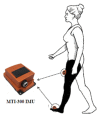Pedestrian Navigation Method Based on Machine Learning and Gait Feature Assistance
- PMID: 32164287
- PMCID: PMC7085699
- DOI: 10.3390/s20051530
Pedestrian Navigation Method Based on Machine Learning and Gait Feature Assistance
Abstract
In recent years, as the mechanical structure of humanoid robots increasingly resembles the human form, research on pedestrian navigation technology has become of great significance for the development of humanoid robot navigation systems. To solve the problem that the wearable inertial navigation system based on micro-inertial measurement units (MIMUs) installed on feet cannot effectively realize its positioning function when the body movement is too drastic to be measured correctly by commercial grade inertial sensors, a pedestrian navigation method based on construction of a virtual inertial measurement unit (VIMU) and gait feature assistance is proposed. The inertial data from different positions of pedestrians' lower limbs are collected synchronously via actual IMUs as training samples. The nonlinear mapping relationship between inertial information from the human foot and leg is established by a visual geometry group-long short term memory (VGG-LSTM) neural network model, based on which the foot VIMU and virtual inertial navigation system (VINS) are constructed. The VINS experimental results show that, combined with zero-velocity update (ZUPT), the integrated method of error modification proposed in this paper can effectively reduce the accumulation of positioning errors in situations where the gait type exceeds the measurement range of the inertial sensors. The positioning performance of the proposed method is more accurate and stable in complex gait types than that merely using ZUPT.
Keywords: gait feature assistance; gait phase recognition; machine learning; pedestrian navigation; virtual inertial navigation system.
Conflict of interest statement
The authors declare no conflict of interest.
Figures











References
-
- Qian W.X., Xiong Z., Xie F., Zeng Q.H., Wang Y.T., Zhu S. The key technologies of pedestrian navigation based on micro inertial system and biological kinematics; Proceedings of the 2016 IEEE/ION Position, Location and Navigation Symposium (PLANS); Savannah, GA, USA. 11–14 April 2016; pp. 613–621.
-
- Liu X.X., Wang S.B., Zhang T.W., Huang R., Wang Q.W. A zero-velocity detection method with transformation on generalized likelihood ratio statistical curve. Measurement. 2018;127:463–471. doi: 10.1016/j.measurement.2018.05.113. - DOI
-
- Qian W.X., Zhu X.H., Su Y. Personal navigation method based on foot-mounted MEMS inertial/magnetic measurement unit. J. Chin. Inert. Technol. 2012;20:567–572.
MeSH terms
Grants and funding
LinkOut - more resources
Full Text Sources
Medical

